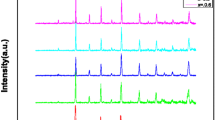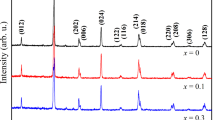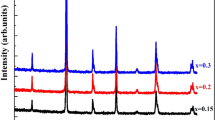Abstract
The crystal structure and magnetic and electric transport properties of polycrystalline La0.50D0.50MnO3−γmanganites (D=Ca, Sr) were studied experimentally depending on the concentration of oxygen vacancies. The La0.50Sr0.50MnO3−γ system of anion-deficient compositions was found to be stable and possess a perovskite structure only up to the γ=0.25 concentration of oxygen vacancies, whereas, for the La0.50Ca0.50MnO3−γ system, we were able to obtain samples with the concentrations of oxygen vacancies up to γ=0.50. The stoichiometric La0.50D0.50MnO3 (D=Ca, Sr) compositions had O-orthorhombic (Ca) and tetragonal (Sr) unit cells. The unit cell of the anion-deficient La0.50Sr0.50MnO3−γ manganites also became O-orthorhombic when the concentration of oxygen vacancies increased γτ;0.16). Oxygen deficiency in La0.50Sr0.50MnO3−γ first caused the transition from the antiferromagnetic to the ferromagnetic state γ∼0.06) and then to the spin glass state γ∼0.16). Supposedly, the oxygen vacancies in the reduced La0.50Sr0.50MnO3− γ samples with γ≥0.16 were disordered. The special feature of the La0.50Ca0.50MnO3−γ manganites was a nonuniform distribution of oxygen vacancies in the La0.50Ca0.50MnO2.75 phase. In the La0.50Ca0.50MnO2.50 phase, the type of oxygen vacancy ordering corresponded to that in Sr2Fe2O5, which led to antiferromagnetic ordering. The specific electric resistance of the La0.50D0.50MnO3−γ anion-deficient samples increased with increasing oxygen deficiency. The magnetoresistance of all samples gradually increased as a result of the transition to the magnetically ordered state. Supposedly, the La0.50Ca0.50MnO3−γ manganites in the range of oxygen vacancy concentrations 0.09≤γ≤0.50 had a mixed state and contained microdomains with different types of magnetic ordering. The experimentally observed properties can be interpreted based on the model of phase layering and the model of superexchange magnetic ordering.
Similar content being viewed by others
References
R. M. Kusters, D. A. Singleton, D. A. Keen, et al., Physica B (Amsterdam) 155, 362 (1989).
Y. Tokura and Y. Tomioka, J. Magn. Magn. Mater. 200, 1 (1999).
E. Dagotto, T. Hotta, A. Moreo, et al., Phys. Rep. 344, 1 (2001).
E. E. Havinga, Philips Res. Rep. 21, 432 (1966).
G. Matsumoto, J. Phys. Soc. Jpn. 29, 606 (1970).
K. Kubo, J. Phys. Soc. Jpn. 33, 21 (1972).
E. L. Nagaev, Phys. Rep. 346, 387 (2001).
P. Schiffer, A. P. Ramírez, W. Bao, et al., Phys. Rev. Lett. 75, 3336 (1995).
A. Urushibara, Y. Moritomo, T. Arima, et al., Phys. Rev. B 51, 14103 (1995).
V. M. Loktev and Yu. G. Pogorelov, Fiz. Nizk. Temp. 26, 231 (2000) [Low Temp. Phys. 26, 171 (2000)].
I. Dzialoshinsky, J. Phys. Chem. Solids 4, 241 (1958).
G. H. Jonker and J. H. Van Santen, Physica (Utrecht) 16, 337 (1950).
J. M. D. Coey, M. Viret, and S. von Molnar, Adv. Phys. 48, 167 (1999).
S. Jin, T. H. Tiefel, M. McCormack, et al., Science 264, 413 (1994).
J. W. Lynn, R. W. Erwin, J. A. Borchers, et al., Phys. Rev. Lett. 76, 4046 (1996).
Y. Tomioka, A. Asamitsu, Y. Moritomo, and Y. Tokura, Phys. Rev. Lett. 74, 5108 (1995).
Y. Moritomo, A. Machida, S. Mori, et al., Phys. Rev. B 60, 9220 (1999).
F. Rivadulla, M. Freita-Alvite, M. A. López-Quintela, et al., J. Appl. Phys. 91, 785 (2002).
P. Levy, F. Parisi, G. Polla, et al., Phys. Rev. B 62, 6437 (2000).
C. H. Chen and S.-W. Cheong, Phys. Rev. Lett. 76, 4042 (1996).
H. Watanabe, J. Phys. Soc. Jpn. 16, 433 (1961).
S. I. Patil, S. M. Bhagat, Q. Q. Shu, et al., Phys. Rev. B 62, 9548 (2000).
C. Zener, Phys. Rev. 82, 403 (1951).
P.-G. De Gennes, Phys. Rev. 118, 141 (1960).
J. B. Goodenough, A. Wold, R. J. Arnott, and N. Menyuk, Phys. Rev. 124, 373 (1961).
I. O. Troyanchuk, S. V. Trukhanov, D. D. Khalyavin, et al., Fiz. Tverd. Tela (St. Petersburg) 42, 297 (2000) [Phys. Solid State 42, 305 (2000)].
I. O. Troyanchuk, S. V. Trukhanov, H. Szymczak, et al., Zh. Éksp. Teor. Fiz. 120, 183 (2001) [JETP 93, 161 (2001)].
S. V. Trukhanov, I. O. Troyanchuk, H. Szymczak, and K. Barner, Phys. Status Solidi B 229, 1417 (2002).
S. V. Trukhanov, N. V. Kasper, I. O. Troyanchuk, et al., J. Solid State Chem. 169, 85 (2002).
S. V. Trukhanov, I. O. Troyanchuk, I. M. Fita, et al., J. Magn. Magn. Mat. 237, 276 (2001).
S. V. Trukhanov, I. O. Troyanchuk, M. Hervieu, et al., Phys. Rev. B 66, 184424 (2002).
J. M. González-Calbet, M. Vallet-Regi, M. A. Alario-Franko, et al., Mater. Res. Bull. 18, 285 (1983).
J. B. Wiley, M. Sabat, S. J. Hwu, et al., J. Solid State Chem. 87, 250 (1990).
S. V. Trukhanov, I. O. Troyanchuk, N. V. Pushkarev, and G. Szymczak, Zh. Éksp. Teor. Fiz. 122, 356 (2002) [JETP 95, 308 (2002)].
S. V. Trukhanov, N. V. Kasper, I. O. Troyanchuk, et al., Phys. Status Solidi B 233, 321 (2002).
J. M. González-Calbet, E. Herrero, N. Rangavittal, et al., J. Solid State Chem. 148, 158 (1999).
J. Alonso, E. Herrero, J. M. González-Calbet, et al., Phys. Rev. B 62, 11328 (2000).
J. Alonso, A. Arroyo, J. M. González-Calbet, et al., Phys. Rev. B 64, 172410 (2001).
Author information
Authors and Affiliations
Additional information
__________
Translated from Zhurnal Éksperimental’no\(\overset{\lower0.5em\hbox{$\smash{\scriptscriptstyle\smile}$}}{l}\) i Teoretichesko\(\overset{\lower0.5em\hbox{$\smash{\scriptscriptstyle\smile}$}}{l}\) Fiziki, Vol. 123, No. 6, 2003, pp. 1200–1211.
Original Russian Text Copyright © 2003 by Troyanchuk, Trukhanov, Shapovalova, Khomchenko, Tovar, Szymczak.
Rights and permissions
About this article
Cite this article
Troyanchuk, I.O., Trukhanov, S.V., Shapovalova, E.F. et al. The influence of oxygen vacancies on the magnetic state of La0.50D0.50MnO3−γ (D=Da, Sr) manganites. J. Exp. Theor. Phys. 96, 1055–1064 (2003). https://doi.org/10.1134/1.1591217
Received:
Issue Date:
DOI: https://doi.org/10.1134/1.1591217




